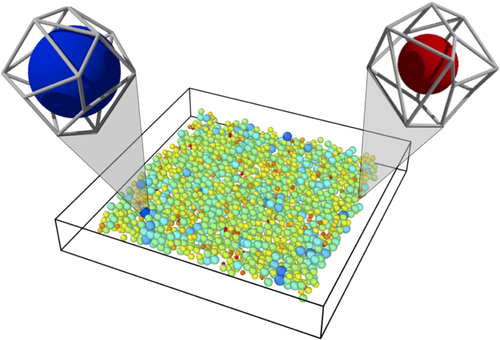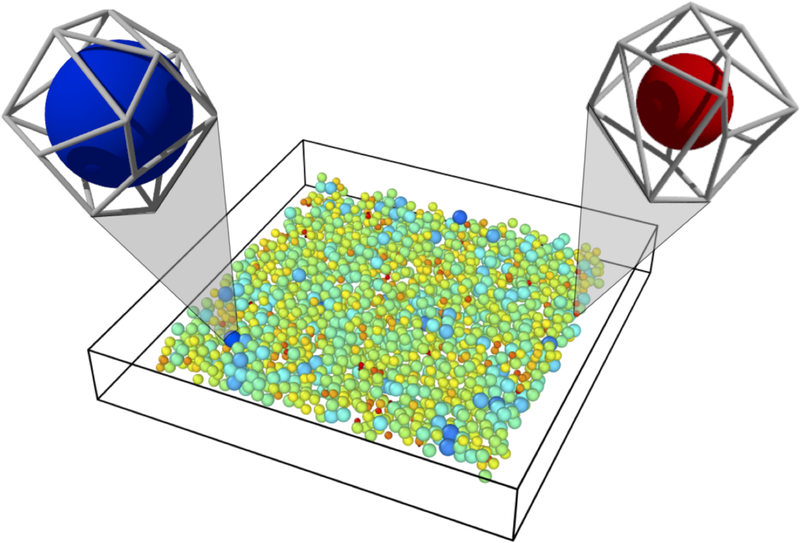For Colloidal Glasses, Size Matters
Glasses (noncrystalline solids) are ubiquitous in industrial materials, but many questions remain about their behavior at the molecular scale. Now researchers have tracked the motion of individual particles representing molecules in a glass and found that smaller particles have more space to “rattle around” than larger particles. They studied a colloidal glass, a solid of randomly arranged, micrometer-sized plastic beads. This particle-size-dependent behavior could influence the mechanical properties of the material, and the results might lead to new ways of controlling the properties of glasses.
Glass materials include not just window glass but also plastics and metal alloys. Even materials like sugar and frozen glycerol have glassy states. These materials are disordered, so they are physically more complicated than crystals. Researchers often study them using model systems, such as microscopic particles that can solidify and stand in for molecules. For example, if you progressively increase the concentration of plastic beads immersed in a liquid, they eventually solidify. If the particles are identical, they form an orderly crystal, but if there are tiny variations in the particles’ sizes—even just a few percent—the order is disrupted, and a “colloidal glass” forms.
Researchers often study colloidal and conventional glasses with visible light or x-ray scattering techniques that probe large areas of the material in one go, giving average information about the structure of the glass and the motion of particles or molecules. To study a colloidal glass on the single-particle level, researchers need a technique that can simultaneously distinguish, monitor, and measure the sizes of individual particles, says Marco Laurati of the University of Guanajuato in Mexico.
Eric Weeks of Emory University in Atlanta and his colleagues recently developed a system that uses confocal microscopy—a 3D imaging technique—to measure particle sizes with high accuracy in a variety of colloidal samples [1]. Now Laurati and his colleagues have used this technique to study a colloidal glass in more detail.
In their experiments, the team made a glass of micrometer-sized plastic particles and then measured their sizes and tracked their trajectories over time. They found that the volume of space surrounding each particle was similar, so smaller particles had more space to move around and were less tightly “boxed in” by their neighbors than larger particles. This result suggests that small and large particles might “feel” different degrees of rigidity—or “glassiness”—says Laurati. Tightly packed, larger particles are stuck where they are, but loosely packed, smaller particles could potentially swap places with their neighbors, a behavior typically only seen in fluids.
This experiment marks the first time that the effects of size variations and particle mobility have been directly linked, says materials physicist Joris Sprakel from Wageningen University in the Netherlands. Weeks, whose particle-size measuring technique was used, says that Laurati and his colleagues have taken the method “past anything I envisioned.”
The results potentially explain why some regions of a material can appear more liquid-like, while others seem more solid-like, even though the structure doesn’t vary significantly. “It would be fascinating to see if fine-tuning the particle size distribution is a way to design more or less glassy systems” and control mechanical properties, says Weeks. For example, says Sprakel, the number of particles in paints is limited by the need for the mixture to remain liquid enough to be brushed onto a wall, but a higher particle density would lead to higher quality finishes that contain less toxic fluid. Increasing the density without sacrificing “paintability” might be possible through manipulating the particle sizes. “That could help bring the coatings industry to a cleaner and greener place,” says Sprakel.
This research is published in Physical Review Letters.
–Katherine Wright
Katherine Wright is the Deputy Editor of Physics Magazine.
References
- R. Kurita, D. B. Ruffner, and E. R. Weeks, “Measuring the Size of Individual Particles from Three-Dimensional Imaging Experiments,” Nat. Commun. 3, 1127 (2012).





